For the exciting tale of Rexroth’s turbulent Hoosier upbringing and the mischief he got into along the way, see part one: The Midwestern Making of Kenneth Rexroth.
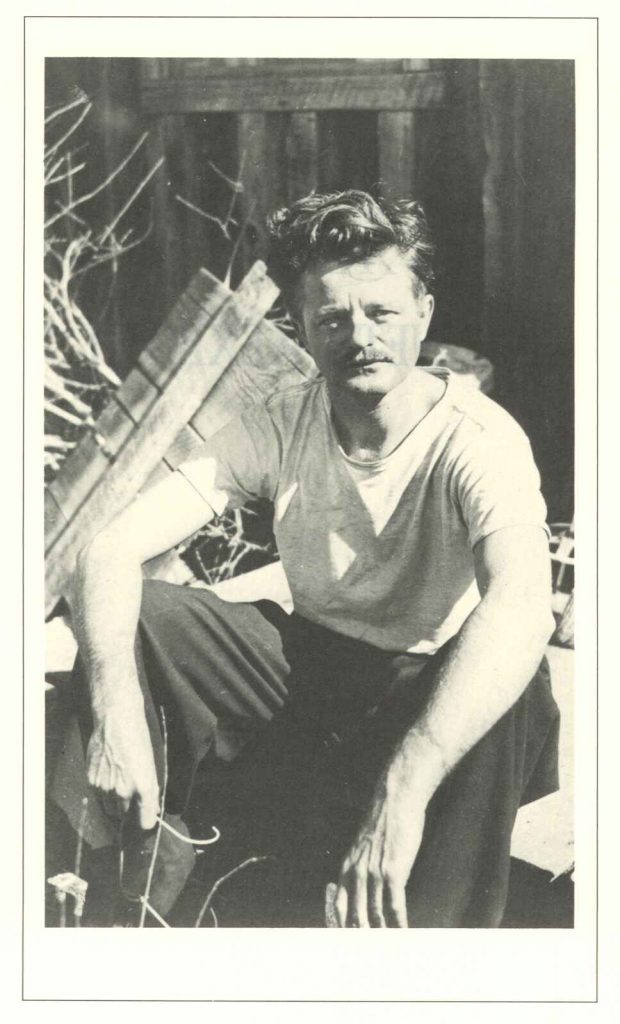
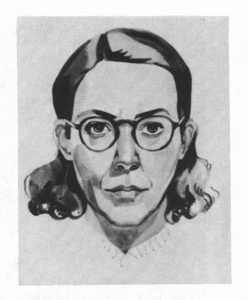
After a period of hitchhiking their way towards the West Coast, camping, and living on cold food, the twenty two-year-old burgeoning poet Kenneth Rexroth and his new artist wife Andrée, arrived in San Francisco in the summer of 1927. Rexroth biographer, Linda Hamalian, referred to them as “forerunners of the flower children who flocked to Northern California during the fifties and sixties.” In San Francisco they found exactly what they had been hoping for: a rich cultural environment without the pretense they sensed in the East Coast artistic community.
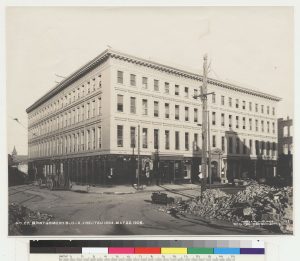
They quickly met other artists and writers and found jobs painting furniture. They moved into an apartment on the Montgomery Block, often called the Monkey Block, that had long housed artists and writers, including the Hoosier author Ambrose Bierce. Rexroth wrote that they had little money, but “limited needs” and were able to live “the kind of life that I’ve lived almost always since, a sort of semi-monastic life devoted to writing and painting.”
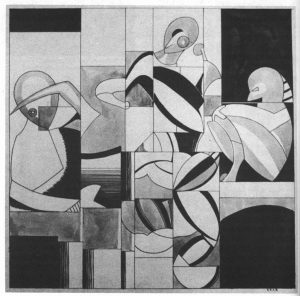
The young couple also spent time enjoying the lush and varied natural environment surrounding San Francisco which Rexroth wrote “kept me in California all these years.” They swam and hiked and noted the unique flora and fauna. This love for nature deeply influenced Rexroth’s writing and he worried about destruction of the natural world by developers. In later years, he described himself as a sort of early environmentalist writer:
My poetry and philosophy of life became what it’s now fashionable to call ecological. I came to think of myself as a microcosm in a macrocosm, related to chipmunks and bears and pine trees and stars and nebulae and rocks and fossils, as part of an infinitely interrelated complex of being. This I have retained.
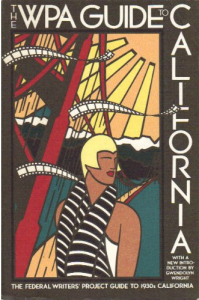
By the 1930s, in the midst of the Great Depression, Rexroth was employed by the Work’s Progress Administration (WPA) contributing to the “American Guide” series of handbooks for each state. Rexroth and several other local poets and writers created the California guide and were able to inject information on natural conservation and into the otherwise standard guidebook.
While he had contributed scattered “cubist poetry” to what Hamalain described as “ephemeral publications” upon his arrival in San Fransisco, by the 1930s he was regularly writing and publishing work in journals and small volumes of poetry. Much of this poetry combined natural imagery with his radical leftist political beliefs and strong anti-war sentiment. For example, his poem “At Lake Desolation,” published in the magazine The New Republic in 1935, contrasted the stillness of nature with the horrors of war. The poem begins:
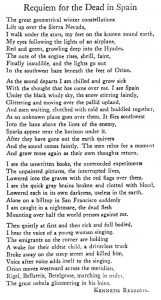
The sun is about to come up and the regiments lie
scattered in the furrow their large eyes
wet in the pale light and their throats cut
He explored similar themes in his poetry throughout the 1930s and became a staunch pacifist. In 1937, the New Republic journal published Rexroth’s poem “Requiem for the Dead in Spain,” lamenting the horrors of the Spanish Civil War. He began the work by describing his walk through the beautiful Sierra Mountains under the stars, the tone changes as he suddenly feels sick thinking about the war. He laments:
I see the unwritten books, the unrecorded experiments,
The unpainted pictures, the interrupted lives,
Lowered into the graves with the red flags over them.
I see the quick gray brains broken and clotted with blood,
Lowered each in its own darkness, useless in the earth.
Alone on a hilltop in San Francisco suddenly
I am caught in a nightmare, the dead flesh
Mounting over half the world presses against me.
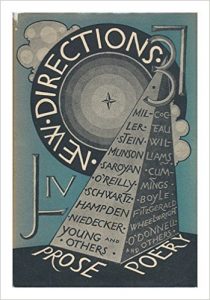
That same year, the influential independent publisher James Laughlin included Rexroth’s work in his second annual New Directions in Poetry and Prose, a publication the Academy of American Poets referred to as “pivotal.” In 1940, Macmillan published Rexroth’s first major collection, In What Hour. The work was considered wholly original and cemented his place at the forefront of the San Francisco literary movement. A reviewer for the Oakland Tribune wrote: “Rexroth is wholly and essentially a poet in the new manner. Usually a poet’s first work, and this is Rexroth’s first book, enables the acute reader to name his literary progenitors. But Rexroth’s poetical parents, if he has any, are not known.” The critic continued, “Despite this break with tradition, or it may be, as the apostles of the modern poetry claim, because of this independence, Rexroth’s book is important and tremendously interesting.” Hamalain wrote that the poems that make up In What Hour “demonstrate his remarkable ability to render plausible the possibility of spiritual presence and a sense of unity in the natural world” despite the threats of the modern age.
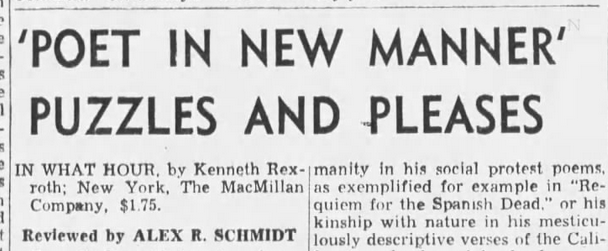
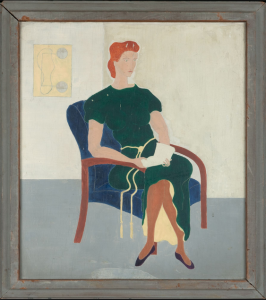
While his writing career was taking off, his marriage was dissolving. Rexroth moved out and began a relationship with Marie Kass, a “whipsmart” nurse, who would become his second wife in 1941. While he was happy with Marie, he was devastated when Andrée died October 17, 1940 from a seizure. He wrote of Andrée in a poem published in The Phoenix and the Tortoise:
I know that spring again is splendid
As ever, the hidden thrush
As sweetly tongued, the sun as vital —
But these are the forest trails we walked together,
These paths, ten years together.
We thought the years would last forever,
They are all gone now, the days
We thought would not come for us are here.
This idea, that love and nature could serve as spiritual refuge in troubled times, became even more significant with the outbreak of World War II and the entry of the United States into the conflict in 1941. Rexroth maintained his pacifist stance and applied for conscientious objector status February 19, 1943. Throughout the war, Rexroth worked with pacifist organizations such as the Fellowship of Reconciliation, the American Friends Service Committee, and the local branch of the National Committee for Conscientious Objectors. He wrote that at one point he received a notice from his draft board that his status had been changed from 4-E, conscientious objector to 1-A, available for armed service. He wrote, “I immediately appealed. The process dragged on for over a year while the FBI investigated the claim as by law they were required to do . . . There was no question that I was a bona-fide Conscientious Objector.”
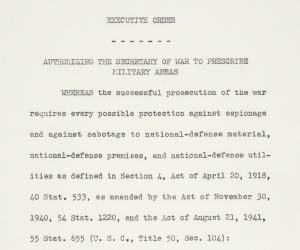
After the Japanese attack on Pearl Harbor on December 7, 1941, some Americans began questioning the loyalty of Japanese Americans, a large number of whom lived on the West Coast. In February 1942, President Roosevelt issued Executive Order 9066 which relocated Japanese Americans, including native born citizens, inland, away from the coast (which had been identified as the Pacific military zone) and confined them to internment camps. Thousands were forced to leave their homes and businesses. However, some Americans, including Rexroth, opposed internment as racist and unconstitutional.
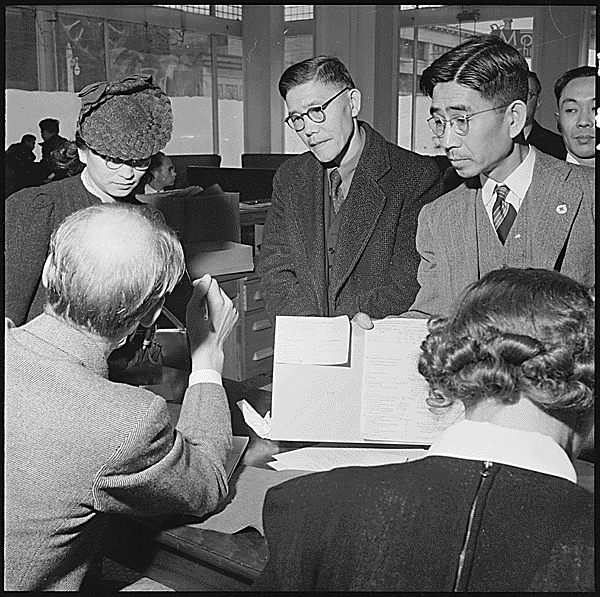
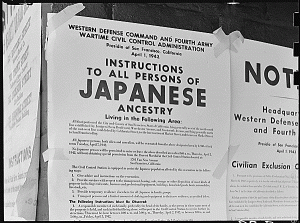
National Archives Identifier: 536017 accessed https://catalog.archives.gov/id/536017
Rexroth wrote in his autobiography that even before the U.S. declared war on Japan, that he worried Japanese Americans would face persecution. He wrote a letter and sent it to various pacifist groups and religious groups, stating that when war was declared, “the persecution of Japanese and Americans of Japanese ancestry, because they are marked by their color and features, will be worse than that of the German-Americans of the First World War.” He wrote in his autobiography, “I managed to persuade them to set up a committee with the absurd title of the American Committee to Protect the Rights of Americans of Oriental Ancestry.” When Rexroth and other members of the Friends Service Committee got word from a “contact in the White House” about the order for internment, they “immediately got on the phones,” and urged each person they called to call five more people. They also called university and political contacts and civil liberties organizations. While perhaps an aggrandizement, Rexroth credited this work with mobilizing opinion in the Bay Area against internment.
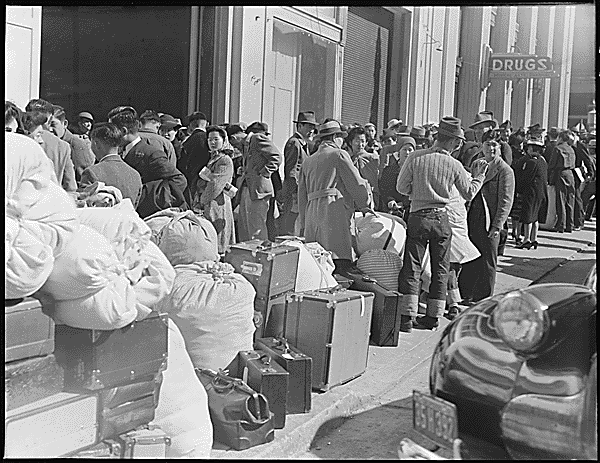
National Archives Identifier: 536065, accessed https://catalog.archives.gov/id/536065
Rexroth took more direct action as well. Again according to his autobiography, Rexroth explained a scheme that saved several Japanese-Americans, including a personal friend, from internment. He contacted the Midwest Art Academy in Chicago, which he called a “phony correspondence school” that advertised scholarships “in cheap pulp magazines” for classes on “photo retouching, art, dress design, and knitting.” He convinced the school to sign registration papers for Japanese American students for a fee. He then contacted the “colonel in charge” of evacuation in San Francisco who agreed to provide educational passes for such students despite the school’s organization being “kind of a racket.” He located funding through Jewish residents of San Francisco and worked with Quakers to “set up a student relocation program.” In this way, Rexroth wrote, “we started shoveling people our of the West Coast on educational passes.” The poet Robert Duncan wrote that both Kenneth and Marie were also “working in the camps . . . taking messages back and forth.”
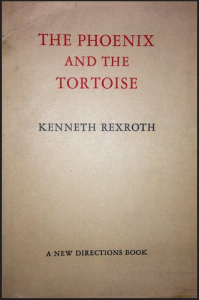
Rexroth’s practice of Buddhism, Taoism, and yoga also influenced his pacifist views and actions. He incorporated this worldview, along with a belief of the transcendental power of love, into his writing. In 1944, New Directions Press published Rexroth’s The Phoenix and the Tortoise, a rumination on history and humanity’s major failings: war and its threat to the natural landscape. In this lengthy poem, there is still hope for humanity in nature and through love. While the tortoise represented the earthly and the mortal, the phoenix represented the transcendent, sublime, and immortal power of love. Likewise, the ocean symbolized nature’s power to transform and serve as sanctuary in a world threatened by war. Literary critic John Palattella explained, “Nature’s indifference to human death is not a threat but a source of consolation, since the ocean’s one unchanging characteristic is that it changes everything.”
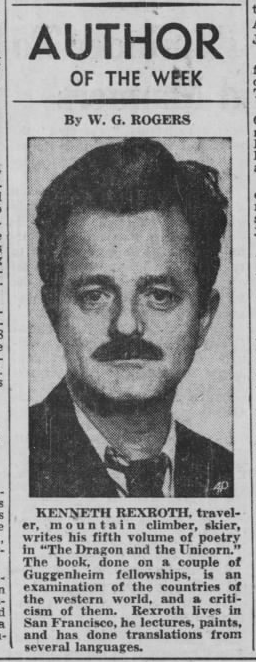
While Rexroth and a small number of avante-garde writers flourished in the San Francisco area for several years, the end of the war in 1945 saw an influx of new artists and writers. Many of these new voices were drawn to the area because they had read Rexroth’s works and heard about the creative coterie he had organized: a group of rebellious writers who were exploring anti-establishment and far left politics in their literature along with other cultural critiques. Rexroth believed it was the war itself that created this cultural climate. He wrote in San Francisco Magazine:
Just as London under the buzz bombs enjoyed a literary renaissance and a profound change of social relationships . . . so San Francisco during the War woke up from a long provincial sleep and became culturally a world capital.
Rexroth also maintained what Beat scholar John Tytell called “a sort of western salon, a weekly literary gathering,” where Rexroth introduced poets to each other and hosted readings. Out of this meeting of minds came “an entirely new cultural synthesis,” which produced new movements in theater, art, and poetry. One newspaper described this literary gathering in 1948 as “the San Francisco bay area poetry forum,” but the broader movement became known as the San Francisco Renaissance. Rexroth considered the combination of political discussion, poetry, and jazz to be the foundation of the movement. Over the following decade, this San Francisco Renaissance ushered in the rise of the Beat Generation. Rexroth’s role as bandleader of the San Francisco movement was responsible for his gaining the title “Father of the Beat Poets,” though he would later reject the title and the movement.
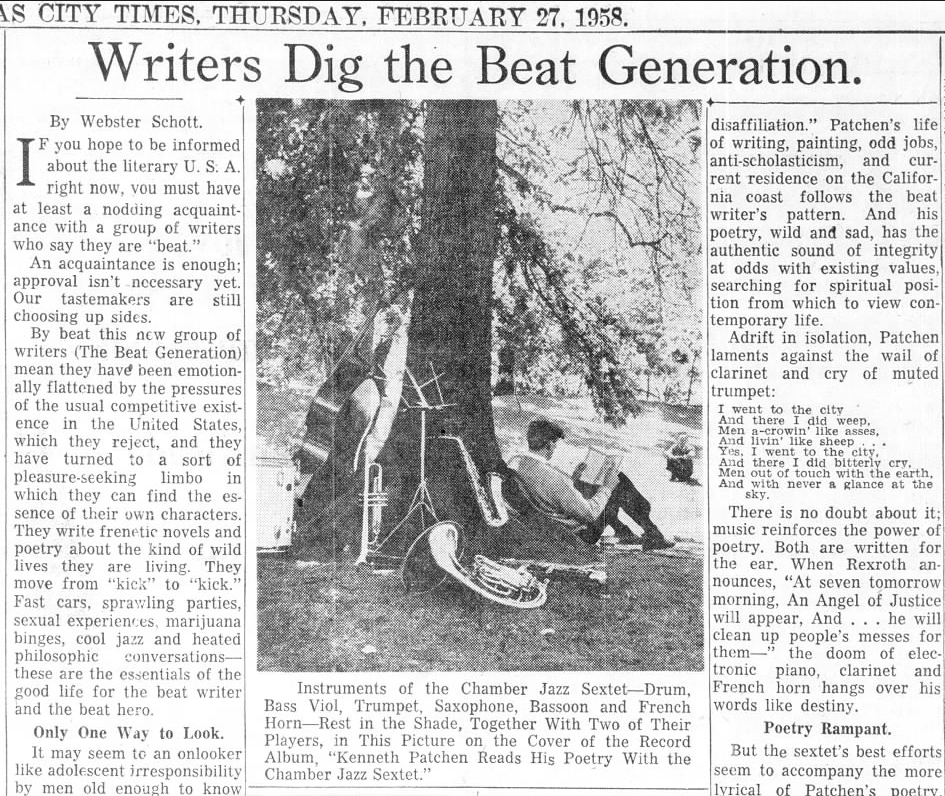
According to the Academy of American Poets, “Beat poetry evolved during the 1940s in both New York City and on the West Coast, although San Francisco became the heart of the movement in the early 1950s.” The Beat Generation rejected mainstream culture and politics and expressed themselves through new and non-conventional forms of poetry. Beat scholars point to the salon-type meetings organized by Rexroth as essential to bringing the Beats together. In the gatherings, the Beats would explore and embrace influential themes in Rexroth’s prolific writings like anarchism, pacifism, mysticism, and environmentalism. Beat scholar Ann Charters also credits Rexroth’s writings on Asian philosophy as influencing the Beat writers’ interest in “Buddha consciousness.”
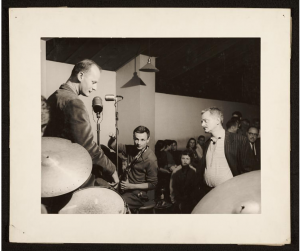
Rexroth also helped establish jazz as an essential element of Beat poetry. During this period, Rexroth gained fame for combining his poetry with the music of local jazz groups. In San Francisco, he often performed at the Cellar, which became known for jazz and poetry performances and at the Blackhawk club with jazz bands like the Dave Brubeck Quartet. Two such performances were released on vinyl in 1957 and 1959.
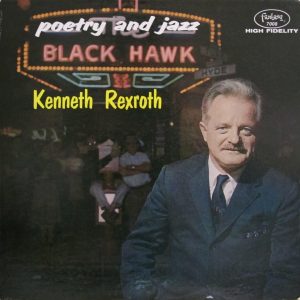
Rexroth toured the country, performing regularly in New York City. According to the Academy of American Poets:
Rexroth was among the first twentieth-century poets to explore the prospects of poetry and jazz in tandem. He championed jazz and its musicians, publishing appreciations of players like Charles Mingus and Ornette Coleman, defending jazz in print against critics who deemed the music less than serious, and most importantly, he played in a jazz band himself, helping to define a role for the poet in the jazz world and a role for jazz in the poetry world.
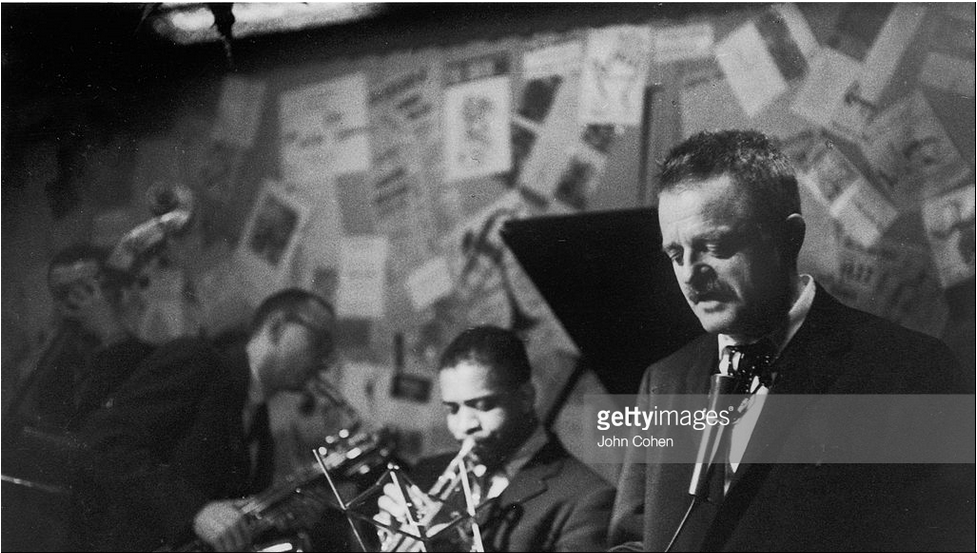
In the liner notes for his 1959 recording Poetry and Jazz at the Blackhawk, Rexroth wrote that jazz poetry “takes the poet out of the bookish, academic world” and returns the poetry to the realm of public entertainment. Rexroth believed that combining music and spoken word connected the audience and poet directly (as opposed to the mediation of the written word) and restored poetry to oral tradition.
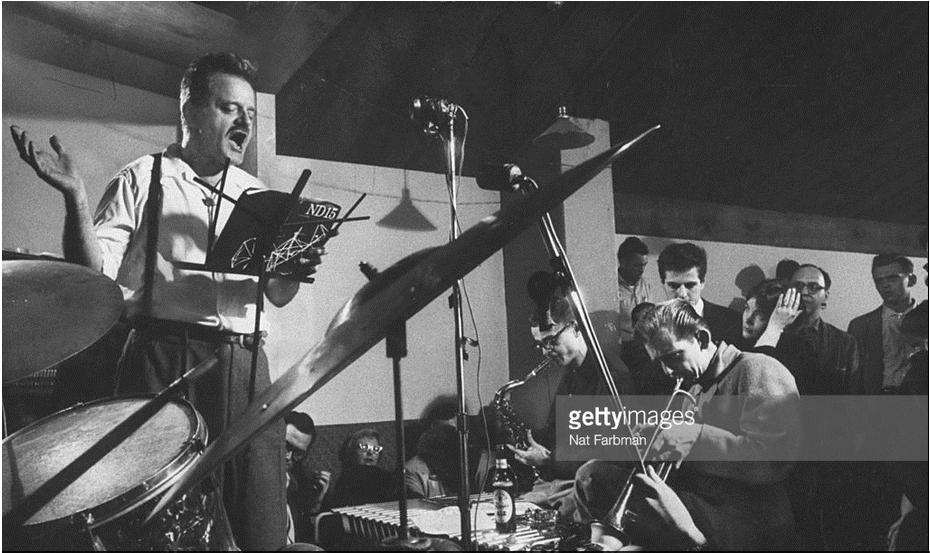
February 1, 1957, Getty Images, accessed gettyimages.com.uk
Mainly, however, it was his rejection of mainstream culture that aligned Rexroth with the Beat movement early on. For example, in 1951, in a syndicated review of Rexroth’s poem “The Dragon and the Unicorn” one critic noted that these rebellious writers were reacting to the post-war period with disgust. He stated that though in their writing style, they break with tradition, but their rebellion makes them part of a long tradition of creativity.
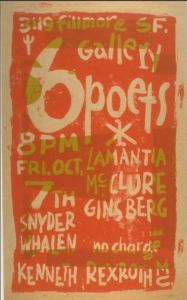
On October 7, 1955, at a poetry reading at the Six Gallery in San Francisco, Rexroth introduced Allen Ginsberg who read his revolutionary poem “Howl.” Scholars often point to this as the culminating event of the San Francisco Renaissance and solidification of the Beat movement. Charters described the movement as “awakening a new awareness in the audience (at the Six Gallery) of the large group of talented young poets in the city, and giving the poets themselves a new sense of belonging to a community.”
Rexroth championed many of the new writers in a 1957 article for The Nation, including high praise for Ginsberg. He described the scene at the height of the movement:
Poetry readings to large and enthusiastic audiences are at least weekly occurrences – in small galleries, city museums, community centers, church social halls, pads and joints, apartments and studios, and at the very active Poetry Center at San Francisco State College, which also imports leading poets . . . Poetry out here, more than anywhere else, has a direct, patent, measurable, social effect, immediately grasped by both poet and audience.
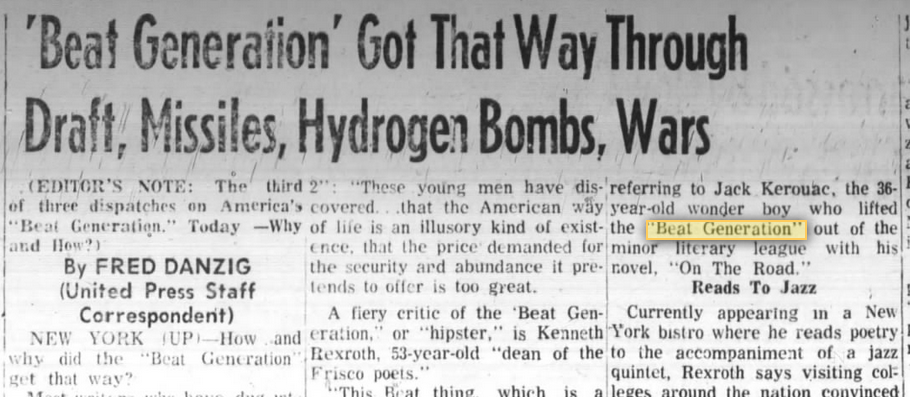
Rexroth argued that the Beat movement started as a radical literary movement, but quickly turned into a “hipster lifestyle,” that is, the pursuit of fashionable trends and not larger truths. He soon distanced himself from the movement because he felt the East Coast Beats, and especially Jack Kerouac, were opportunists seeking fame and mainstream acceptance. Rexroth was quoted by a reporter in 1958 as saying, “This beat thing, which is a publicity gimmick in the hands of Madison Avenue, will die away.”
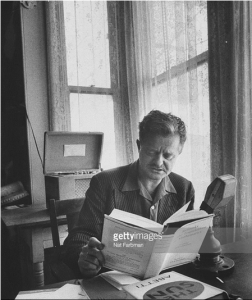
Regardless, Rexroth had directly influenced the Beat movement probably more so than any other poet. In 1958, one reporter astutely wrote that Rexroth “seems to fix the entrance requirements.” Charters explained that Rexroth was one of a handful of writers who had “sown the seeds” for the flowering of the Beat movement. She refered to Rexroth as a “mentor” for the younger Beats and “the dominant force in the cultural life of San Francisco for more than half a century.”
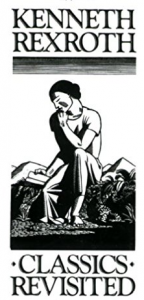
Although the Beat movement melted into the counterculture movements of the sixties and rock and roll became the dominant outlet for rebellious youth, Rexroth remained a central figure in American literature. He continued to write poetry and extensive cultural and literary criticism. In addition to his original contributions, his translations of foreign poetry and his writings on literature such as his “Classics Revisited” column in the Saturday Review increased his importance to the literary world.
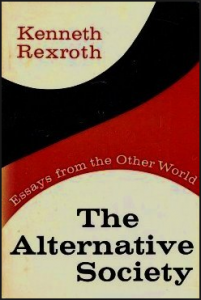
Writing for the Chicago Review, Rexroth scholar Ken Knabb looked back on the over 800 columns that Rexroth wrote for the San Francisco Examiner, the San Francisco Bay Guardian and San Francisco Magazine during the 1960s and 1970s. Knabb wrote in admiration of the diversity of topics that Rexroth covered: reviews of jazz and classical concerts, operas, films, Chinese theater, performances of Shakespeare; discussions of art, literature, fishing, architecture, drugs, wine, Civil Rights, war, and politics; observations from his world travels; arguments for the women’s liberation and ecological movements; and criticisms of the past cultural movements through which he lived and participated. Knabb concluded that “as an ensemble . . . they add up to a social document and critical commentary of remarkable range.”
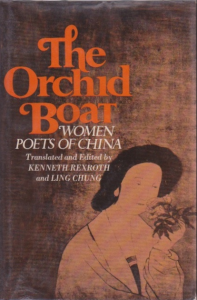
While Rexroth had begun translating poetry from other languages in the 1950s, he dedicated more and more of his time to the task later in life. He paid special attention to translating the work of women poets starting in the 1970s in works such as The Orchid Boat: Women Poets of China (1972) and The Burning Heart: The Women Poets of Japan (1977). By this point, his own work incorporated imagery and meter learned through decades of translating Chinese and Japanese poetry.
In his review of Rexroth’s collection The Morning Star (1979), critic Emiko Sakurai praised these poems especially as “extraordinary poems, rich and sensuous, always immediate, febrile and powerful” and called Rexroth “a poet of the first rank.” However, Sakurai had a hunch about Rexroth. He noted that “The Love Poems of Marichiko” were “ostensibly” written by a young Japanese woman. Indeed, they were actually written by Rexroth from this imagined perspective. Critics noted the transformative power his work as a translator had on his own original work and his ability to write convincingly from the a feminine perspective of his invented character.
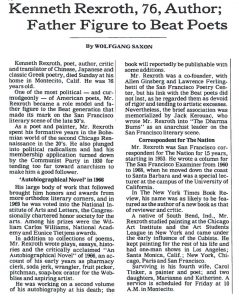
Upon Rexroth’s death in 1982, the New York Times described this “poet, author, critic and translator of Chinese, Japanese and classic Greek poetry” as greatly influential on later generations of writers. The Times obituary noted that he received acclaim from both radical literary and political circles as well as “honors and awards from more orthodox literary corners,” such as Guggenheim fellowships and a prestigious grant from the National Institute of Arts and Letters in 1964.
Although he came to despise being called “Father of the Beats,” Rexroth created a cultural movement that influenced the voice and worldview of some of America’s best poets. Frankly, there would be no Ginsberg or Kerouac without Rexroth. However, it is his own unique voice that will forever hold his place in this country’s literary canon. Perhaps the best summary of his significance comes from poet and publisher James Laughlin, who described his friend Kenneth Rexroth aptly as “an American cultural monument.”
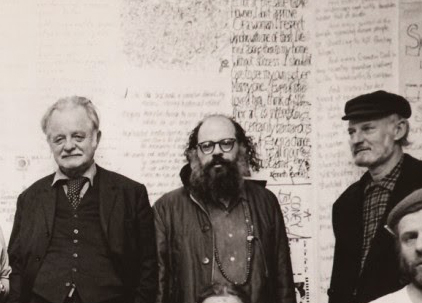
Further reading:
Linda Hamalian, A Life of Kenneth Rexroth (New York and London: W. W. Norton & Company, 1991).
Ann Charters, ed., The Portable Beat Reader (New York: Penguin Books, 1992).
